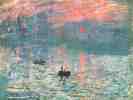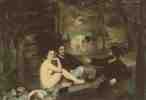![]()
The impressionist style of painting is characterized chiefly by concentration on the general impression produced by a scene or object and the use of unmixed primary colors and small strokes to simulate actual reflected light.
Impressionism, French Impressionnisme, a major movement, first in painting and later in music, that developed chiefly in France during the late 19th and early 20th centuries. Impressionist painting comprises the work produced between about 1867 and 1886 by a group of artists who shared a set of related approaches and techniques. The most conspicuous characteristic of Impressionism was an attempt to accurately and objectively record visual reality in terms of transient effects of light and colour. The principal Impressionist painters were Claude Monet, Pierre Auguste Renoir, Camille Pissarro, Alfred Sisley, Berthe Morisot, Armand Guillaumin, and Frédéric Bazille, who worked together, influenced each other, and exhibited together independently. Edgar Degas and Paul Cézanne also painted in an Impressionist style for a time in the early 1870s. The established painter Édouard Manet, whose work in the 1860s greatly influenced Monet and others of the group, himself adopted the Impressionist approach about 1873.
Tout l'impressionnisme est né de la contemplation
et de l'imitation des impressions claires du Japon.
-- Ed. et J. de Goncourt, Journal, 19 avr. 1884.
En réalité l'Impressionnisme est multiple: le terme si critiqué
est surtout mauvais parce qu'on l'emploie tantôt dans un sens large,
tantôt dans un sens étroit. Il y a l'impressionnisme de
Manet
qui peint clair.
Il y a celui de Manet encore et de
Degas
qui spécule sur l'emploi
d'une nouvelle perspective. Il y a celui de
Pissarro et de
Renoir
qui se fondent sur le plein air et l'emploi des tons purs.
Il y a enfin celui de
Monet
qui unit une conception lyrique de la vision
avec une analyse quasi scientifique des sensations colorées et qui
substitue au dessin classique la notation des ombres et des reflets.
Toutes ces tendances ont un caractère commun: elles se fondent sur
une tentative pour substituer aux conventions de l'école l'analyse des
données pures des sens. Et c'est par là qu'elles méritent finalement
toutes, en commun, le nom d'Impressionnisme.
-- P. Francastel, Nouveau dessin, nouvelle peinture, III.
The word ``impressionniste'' was printed for the first time in the Charivari on the 25 April 1874 by Louis Leroy, after Claude Monet's landscape entitled Impressions: soleil levant [Impressions]. This word was used to call Exposition des Impressionnistes an exhibit hold in the salons of the photographer Nadar and organized by the ``Société anonyme des peintres, sculpteurs et graveurs'' [``Anonymous society of painters, sculptors and engravers''], composed of Pissarro, Monet, Sisley, Degas, Renoir, Cézanne, Guillaumin and Berthe Morisot.
 Impression: soleil levant
Impression: soleil levant
Claude Monet
The founders of this society were animated by the will to break with the official art. The official theory that the color should be dropped pure on the canvas instead of getting mixed on the palette will only be respected by a few of them and only for a couple of years. In fact, the Impressionism is a lot more a state of the mind than a technique; thus artists other than painters have also been qualified of impressionists. Many of these painters ignore the law of simultaneous contrast as established by Chevreul in 1823. The expressions ``independants'' or ``open air painters'' may be more appropriate than ``impressionists'' to qualify those artists continuing a tradition inherited from Eugène Delacroix, who thought that the drawing and colors were a whole, and English landscape painters, Constable, Bonington and especially William Turner, whose first law was the observation of nature, as for landscape painters working in Barbizon and in the Fontainebleau forest.
Eugène Boudin, Stanislas Lépine and the Dutch Jongkind were among the forerunners of the movement. In 1858, Eugène Boudin met in Honfleur Claude Monet, aged about 15 years. He brought him to the seashore, gave him colors and taught him how to observe the changing lights on the Seine estuary. In those years, Boudin is still the minor painter of the Pardon de Sainte-Anne-la-Palud, but is on the process of getting installed on the Normandy coast to paint the beaches of Trouville and Le Havre. On the Côte de Grâce, in the Saint-Siméon farm, he attracts many painters including Courbet, Bazille, Monet, Sisley. The last three will meet in Paris in the free Gleyre studio, and in 1863 they will discover a porcelain painter, Auguste Renoir.
At the same time, other artists wanted to bypass the limitations attached to the Ecole des Beaux-Arts and were working quai des Orfèvres in the Swiss Academy; the eldest, from the Danish West Indies, was Camille Pissarro; the other two were Paul Cézanne and Armand Guillaumin.
These people were highly impressed by the works of Edouard Manet, and became outraged when they learned that he was refused for the 1863 Salon. The indignation was so high among the artistic population that Napoleon III allowed the opening of a ``Salon des Refusés'', where Manet, Pissarro, Jongkind, Cals, Chintreuil, Fantin-Latour, etc. showed their works. Le Déjeuner sur l'herbe provoked a great enthusiasm among the young painters, who saw represented in Manet's painting many of their concerns. They started meeting around him in the café Guerbois, 9, avenue de Clichy, and thus creating l'école des Batignolles.
 Le Déjeuner sur l'herbe
Le Déjeuner sur l'herbe
Edouard Manet
The 1866 Salon accepted the works of some of them: Degas, Bazille, Berthe Morisot, Sisley; Monet exposed the portrait of Camille, Pissarro, les Bords de la Marne en hiver; Manet, Cézanne, Renoir were refused, and Emile Zola wrote in l'Evenement a diatribe which made him the official upholder of those newcomers bearing an more revolutionary attitude in the conception than in the still traditional painting. The main distinction lies in the attraction for color and the liking of light; but Berthe Morisot remained faithful to Manet's teaching; Degas was mixed between his admiration of Ingres and the Italian Renaissance painters; Cézanne attempted to ``faire du Poussin sur nature''; Claude Monet himself, in la Terrasse au Havre and les Femmes au jardin (1866, Louvre, salles du Jeu de Paume), is far from announcing his future audacity.
The 1870 war split those beginners. Frédéric Bazille was killed in Beaune-la-Rolande; Renoir was mobilized; Degas volunteered; Cézanne retired in Provence; Pissarro, Monet and Sisley moved to London, where they met Paul Durand-Ruel. This stay in London is a major step in the evolution of Impressionism, both because these young artists met there their first merchant, and because they discovered Turner's paintings, whose light analysis will mark them.
Back in Paris, most of these painters went to work in Argenteuil (Monet, Renoir), Chatou (Renoir), Marly (Sisley), or on the banks of the river Oise (Pissarro, Guillaumin, Cézanne). Edouard Manet painted the Seine with Claude Monet and, under his influence, adopted the open air work.
Durand-Ruel was unable to sell the works of the future impressionists and had to cease buying in 1873; thus, next year, they decided to expose in Nadar's (15 April-15 May 1874), where they displayed the works that the Salon had refused. They invited with no success Manet, but Lépine, Boudin, Bracquemond the engraver, Astruc the sculptor, and the painters Cals, de Nittis, Henri Rouart, etc. joined them. Many artists became then conscious of the public and critics incomprehension, but the solidarity didn't last long. Cézanne didn't participate in the group second exhibit, galerie Durand-Ruel, rue Le Peletier, in 1876, which hold 24 Degas and works from Berthe Morisot, Claude Monet, Auguste Renoir, Pissarro, Sisley and Frédéric Bazille. They met some upholders, such as Duranty, Armand Silvestre, Philippe Burty, Emile Blémond, Georges Rivière, soon with Théodore Duret. The disappearance of Cézanne, Renoir, Sisley, Berthe Morisot in the 1879 exhibit proved that the group was splitting apart. Renoir preferred to send to the official Salon Mme Charpentier et ses enfants and the Portrait of Jeanne Samary; yet only few people admired his artworks and of those of his friends, and the artists'life was uneasy, if not miserable. Degas tried, with Pissarro, to maintain the unity of the group, but his attempt failed since Monet, Sisley and Renoir were missing for the fifth exhibit, opened in April 1880; however, artworks from Gauguin appeared there for the first time. In 1881, the some of the Impressionists went back to Nadar's: Pissarro, Degas, Guillaumin, Berthe Morisot. The ``seventh exhibition of independant artists'' was the become the ``Salon des indépendants'' two years later.
Only Monet and Sisley went always deeper into the analysis of light changings and their effects on appearances. Degas, Renoir and Cézanne headed towards opposite directions, whereas Pissarro was interested by the researches of Paul Gauguin, Georges Seurat, Paul Signac. If, at this stage, Impressionists were becoming appreciated, their situation was still harsh; the Salon was still refusing their paintings, and in 1894, 25 out of 65 artworks donated by Caillebotte to the Luxembourg museum were rejected.
Yet, when Camille Pissarro, the Impressionist patriarch, died in 1903, everybody agreed that this movement was the main XIXth century artistic revolution, and that all its members were among the finest painters. The influence of the Impressionists was great out of France, especially in Germany, with Liebermann, Corinth, and in Belgium.